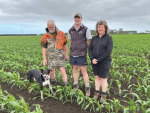Southland's a recent addition to the must-save list, for me prompted by the departure of controversial Environment Southland chief executive, Ciaran Keogh – a mate of mine from way back when he was with the Clutha District Council. He was, and still is, known as an ideas man, usually a bit ahead of his time.
Among his suggestions was replacing the Balclutha bridge because it was causing a traffic bottle neck. He was right, but this was sacrilege to locals.
In Southland, his mission was a serious rethink of its dairy industry as the standard model was fast reaching the stage of too many hooves for the land to support. With many of the easy conversion farms already dairying, the industry needed a huge change to continue its momentum, with it forced out of its comfort zone, possibly onto less suited steeper country.
The reality is dairying in Southland is an industry whose growth has exceeded all expectation. It's meant management changes are having to be made much earlier than expected. These include identifying non-dairy soils, wintering restrictions, and housing.
While there is nothing fanatical about these changes, there probably needs to be an evangelistic group to give leadership. It seems some dairy conversions may struggle to get off the ground under proposed new regulations.
Before he left Environment Southland, Keogh wrote to Fonterra bluntly pointing out the apathy of the cooperative (and some dairy interests) towards environmental performance. The letter was widely circulated and seemed to arouse the response the writer had intended. Having pointed out the obvious problems he also explained possible solutions. However, they all came with a significant cost in the early stages.
Those in the industry were not greatly enthused about changing systems, but some farmers accepted the letter spelt out what was unavoidable.
The obvious quandary is getting cows off the productive country during the winter. Run-off blocks sound reassuring but only relocate the problem. Wintering barns or stand-off pads, while costly, should deliver the greatest economic benefits. Their use will allow the industry to expand well beyond the traditional pastoral system. Here and overseas the increased production with barns or pads can be dramatic, assuming appropriate management.
Keogh's vision was of every farm having a wintering 'facility.' With such facilities come other options: solar panels on roofs, biogas production from waste, joint-venture building.
Whatever happens, the environment will become increasingly sacrosanct. President of Southland Federated Farmers Hugh Gardyne says all sectors of dairy must come together when writing dairying regulations. These would be with forward-thinking industry leaders that represent the new age, not the stone-age. They would have the common objective of making economic progress without compromising the environment.
According to Vaughan Templeton, a former Southland Feds Dairy chairman, progressive rural leaders have been brought together recently by Environment Southland as the Water and Land 20/20 Steering Group. Its membership includes everyone using Southland's waterways – large or small.
Vaughan says the initial key is getting everyone to trust each other in a holistic approach. And it isn't just about dairying.
















